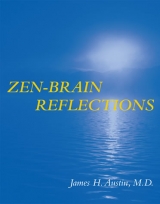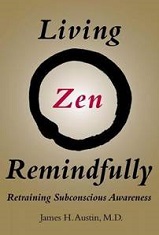ZEN MESTEREK ZEN MASTERS
« Zen főoldal
« vissza a Terebess Online nyitólapjára

James H. Austin (1925-)
James H. Austin is an American neurologist and author. He is the author of the book Zen and the Brain. It establishes links between the neurophysiology of the human brain and the practice of meditation, and won the Scientific and Medical Network Book Prize for 1998. He has written five sequels: Zen-Brain Reflections (2006), Selfless Insight (2009), Meditating Selflessly (2011), Zen-Brain Horizons (2014) and Living Zen Remindfully (2016).
Austin has been a practicing Zen Buddhist since 1974. He began in Kyoto at Daitoku-ji (Ryōkōin 龍光院) as a student of the Rinzai rōshi Kobori [Nanrei] Sōhaku (小堀 [南嶺] 宗柏 1918-1992).
After eight years of regular Zen meditation, Austin experienced the taste of what Zen practice calls kenshō. The chief characteristic of this experience was a loss of the sense of "self" which is so central to human identity, plus a feeling that "Just This" is the way all things really are in the world. While he was on a sabbatical in England, he was waiting for an Underground train when he suddenly entered a state of enlightenment unlike anything he had ever experienced. In Austin's words, "It strikes unexpectedly at 9 am on the surface platform of the London subway system. [Due to a mistake] ... I wind up at a station where I have never been before...The view includes the dingy interior of the station, some grimy buildings, a bit of open sky above and beyond. Instantly the entire view acquires three qualities: Absolute Reality, Intrinsic Rightness, Ultimate Perfection."
"With no transition, it is all complete....Yes, there is the paradox of this extraordinary viewing. But there is no viewer. The scene is utterly empty, stripped of every last extension of an I-Me-Mine [his name for ego-self]. Vanished in one split second is the familiar sensation that this person is viewing an ordinary city scene. The new viewing proceeds impersonally, not pausing to register the paradox that there is no human subject "doing" it. Three insights penetrate the experient, each conveying Total Understanding at depths far beyond simple knowledge: This is the eternal state of affairs. There is nothing more to do. There is nothing whatsoever to fear."
Austin writes that when his former subjective self was no longer there to form biased interpretations this experience conveyed the impression of "objective reality." As a neurologist, he interpreted this experience not as proof of a reality beyond the comprehension of our senses but as arising from the brain itself. This and other experiences and research led him to write Zen and the Brain
https://en.wikipedia.org/wiki/James_H._Austin

PDF: Zen and the Brain: Toward an Understanding of Meditation and Consciousness
Cambridge, MA: MIT Press, 1998.
http://cognet.mit.edu/book/zen-and-brain
https://en.wikipedia.org/wiki/Zen_and_the_Brain
Aldous Huxley called humankind's basic trend toward spiritual growth the "perennial philosophy." In the view of James Austin, the trend implies a "perennial psychophysiology"—because awakening, or enlightenment, occurs only when the human brain undergoes substantial changes. What are the peak experiences of enlightenment? How could these states profoundly enhance, and yet simplify, the workings of the brain? Zen and the Brain presents the latest evidence. In this book Zen Buddhism becomes the opening wedge for an extraordinarily wide-ranging exploration of consciousness. In order to understand which brain mechanisms produce Zen states, one needs some understanding of the anatomy, physiology, and chemistry of the brain. Austin, both a neurologist and a Zen practitioner, interweaves the most recent brain research with the personal narrative of his Zen experiences. The science is both inclusive and rigorous; the Zen sections are clear and evocative. Along the way, Austin examines such topics as similar states in other disciplines and religions, sleep and dreams, mental illness, consciousness-altering drugs, and the social consequences of the advanced stage of ongoing enlightenment.

PDF: Zen-Brain Reflections: reviewing recent developments in meditation and states of consciousness
Cambridge, MA: MIT Press, 2006.
This sequel to the widely read Zen and the Brain continues James Austin's explorations into the key interrelationships between Zen Buddhism and brain research. In Zen-Brain Reflections , Austin, a clinical neurologist, researcher, and Zen practitioner, examines the evolving psychological processes and brain changes associated with the path of long-range meditative training. Austin draws not only on the latest neuroscience research and new neuroimaging studies but also on Zen literature and his personal experience with alternate states of consciousness.
PDF: Selfless Insight: Zen and the Meditative Transformations of Consciousness
Cambridge, MA: MIT Press, 2009.
The Thalamic Gateway: How the Meditative Training of Attention Evolves Toward Selfless States of Consciousness.
Chapter 15 in: B. Bruya (Ed.), Effortless Attention; A New Perspective in the Cognitive Science of Attention and Action.
Cambridge, MA: MIT Press, 2010. pp. 373-407.
PDF: Meditating Selflessly: Practical Neural Zen
Cambridge, MA: MIT Press, 2011.

PDF: Zen-Brain Horizons: Toward a Living Zen
Cambridge, MA: MIT Press, 2014. xxi + 273 pages
In Zen-Brain Horizons, James Austin draws on his decades of experience as a neurologist and Zen practitioner to clarify the benefits of meditative training. Austin integrates classical Buddhist literature with modern brain research, exploring the horizons of a living, neural Zen.

PDF: Living Zen Remindfully: Retraining Subconscious Awareness
Cambridge, MA: MIT Press, 2016.
PDF: Old Joshu Lives On
by James H. Austin
Contemporary Buddhism, 2017, Vol.18, No.1, pp 72-88.